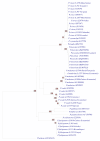First case of detection of Plasmodium knowlesi in Spain by Real Time PCR in a traveller from Southeast Asia
- PMID: 20663184
- PMCID: PMC2921078
- DOI: 10.1186/1475-2875-9-219
First case of detection of Plasmodium knowlesi in Spain by Real Time PCR in a traveller from Southeast Asia
Abstract
Previously, Plasmodium knowlesi was not considered as a species of Plasmodium that could cause malaria in human beings, as it is parasite of long-tailed (Macaca fascicularis) and pig-tailed (Macaca nemestrina) macaques found in Southeast Asia. A case of infection by P. knowlesi is described in a Spanish traveller, who came back to Spain with daily fever after his last overseas travel, which was a six-month holiday in forested areas of Southeast Asia between 2008 and 2009. His P. knowlesi infection was detected by multiplex Real time quantitative PCR and confirmed by sequencing the amplified fragment. Using nested multiplex malaria PCR (reference method in Spain) and a rapid diagnostic test, the P. knowlesi infection was negative. This patient was discharged and asymptomatic when the positive result to P. knowlesi was reported. Prior to this case, there have been two more reports of European travellers with malaria caused by P. knowlesi, a Finnish man who travelled to Peninsular Malaysia during four weeks in March 2007, and a Swedish man who did a short visit to Malaysian Borneo in October 2006. Taken together with this report of P. knowlesi infection in a Spanish traveller returning from Southeast Asia, this is the third case of P. knowlesi infection in Europe, indicating that this simian parasite can infect visitors to endemic areas in Southeast Asia. This last European case is quite surprising, given that it is an untreated-symptomatic P. knowlesi in human, in contrast to what is currently known about P. knowlesi infection. Most previous reports of human P. knowlesi malaria infections were in adults, often with symptoms and relatively high parasite densities, up to the recent report in Ninh Thuan province, located in the southern part of central Vietnam, inhabited mainly by the Ra-glai ethnic minority, in which all P. knowlesi infections were asymptomatic, co-infected with P. malariae, with low parasite densities and two of the three identified cases were very young children under five years old.
Figures


References
-
- Centers for Disease Control and Prevention (CDC) Simian malaria in a U.S. traveler--New York, 2008. MMWR Morb Mortal Wkly Rep. 2009;58:229–232. - PubMed
Publication types
MeSH terms
LinkOut - more resources
Full Text Sources
Medical
Molecular Biology Databases

